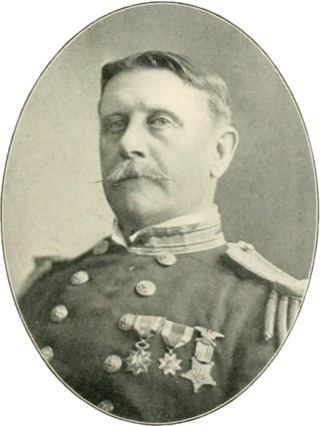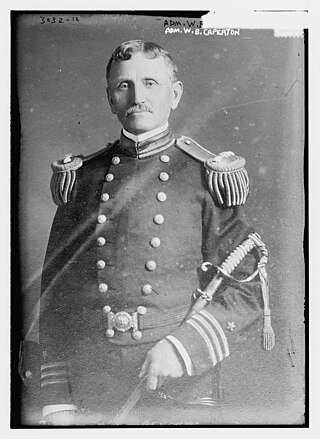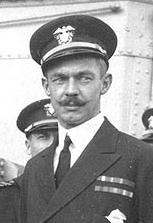
Commander Charles K. Belknap Jr. (September 6, 1880 - December 29, 1954) was the commander of the USS Ammen (DD-35) in 1913. He was the censor for the United States Navy in 1917. [1]

Commander Charles K. Belknap Jr. (September 6, 1880 - December 29, 1954) was the commander of the USS Ammen (DD-35) in 1913. He was the censor for the United States Navy in 1917. [1]
He was born on September 6, 1880, in Concord, Massachusetts to Charles K. Belknap Sr. He attended Yale University from 1898 to 1899, the United States Naval Academy from 1899 to 1903. He married Gladys Goodrich on October 26, 1909, in Pomfret, Connecticut.
Belknap was the commander of the destroyer USS Ammen (DD-35) in 1913 and attended the Naval War College from 1915 to 1916. He was promoted to the rank of lieutenant commander on August 29, 1916.

After the United States' declaration of war on Germany in April 1917, Belknap worked as a censor for the United States Navy. [1] Due to a shortage of experienced officers, he received a temporary promotion to commander on January 1, 1918.
On January 9, 1918, shortly after his promotion to commander, Belknap was appointed director of the newly formed Naval Overseas Transportation Service (NOTS). In this position, Belknap was responsible for Navy cargo ships and all auxiliary vessels not assigned to the fleet or the various naval districts.
After the war's conclusion, Belknap resigned from the Navy on December 7, 1919.
He died on December 29, 1954, in St. Louis, Missouri. He was buried in the United States Naval Academy Cemetery.
In 1919 Belknap received the Navy Cross from the Navy and also the Distinguished Service Medal from the Army for his service with the Naval Overseas Transportation Service during World War I. He was one of a very few individuals to receive both the Navy Cross and the Army Distinguished Service Medal.
He was also entitled to the Victory Medal.

Arthur LeRoy Bristol, Jr. was a vice admiral in the United States Navy, who held important commands during World War I and World War II, and was an early aircraft carrier commander.

The Navy Cross is the United States Naval Service's second-highest military decoration awarded for sailors and Marines who distinguish themselves for extraordinary heroism in combat with an armed enemy force. The medal is equivalent to the Army's Distinguished Service Cross, the Air and Space Forces' Air Force Cross, and the Coast Guard Cross.

William Sowden Sims was an admiral in the United States Navy who fought during the late 19th and early 20th centuries to modernize the navy. During World War I, he commanded all United States naval forces operating in Europe. He also served twice as president of the Naval War College.

Joseph Knefler Taussig was a vice admiral in the United States Navy. He served in the Spanish–American War, Philippine–American War, China Relief Expedition, Cuban Pacification, World War I, Second Nicaraguan Campaign, and World War II.

The first USS Ammen (DD-35) was a Paulding-class destroyer in the United States Navy during World War I and later in the United States Coast Guard, designated as CG-8. She was named for Rear Admiral Daniel Ammen.

The first USS Jenkins (DD-42) was a modified Paulding-class destroyer in the United States Navy during World War I. She was named for Rear Admiral Thornton A. Jenkins.

Vice Admiral Robert Lee Ghormley was an admiral in the United States Navy who served as Commander, South Pacific Area during World War II. Ghormley was long considered to be an ineffective leader–overly cautious, pessimistic, and even defeatist–but recent scholarship has shown that while he may not have been an inspiring leader, he performed well under difficult circumstances.

USS Parker was an Aylwin-class destroyer built for the United States Navy prior to the American entry into World War I. The ship was the first U.S. Navy vessel named in honor of Foxhall A. Parker, Jr., a U.S. Navy officer who served in the American Civil War, and as Superintendent of United States Naval Academy.

Cameron McRae Winslow served in the United States Navy during the Spanish–American War and World War I. He was a son of Commander Francis Winslow (I) (1818–1862), who fought in the Civil War and died of yellow fever in 1862 while in command of USS R. R. Cuyler.

Admiral Hugh Rodman KCB was an officer in the United States Navy who served during the Spanish–American War and World War I, later serving as the Commander-in-Chief, U.S. Pacific Fleet from 1919 to 1921.

Rear Admiral Oscar Walter Farenholt was an officer in the United States Navy during the American Civil War, the Spanish–American War and is the first enlisted man in the Navy to reach flag rank.

William Banks Caperton was an admiral of the United States Navy. He held major posts ashore and afloat, chief of which were commanding the naval forces intervening in Haiti (1915–16) and Santo Domingo (1916), and Commander-in-Chief, Pacific Fleet, from July 28, 1916, to April 30, 1919. He served actively until November 12, 1921.

William Freeland Fullam was an officer in the United States Navy during World War I.

Walter Atlee Edwards was a Lieutenant-Commander in the United States Navy and a recipient of America's highest military decoration – the Medal of Honor.

John Walter Wilcox Jr. was a rear admiral of the United States Navy. He saw service in World War I and in the opening weeks of United States involvement in World War II before being lost overboard from his flagship in the North Atlantic Ocean in 1942.

Admiral James Fife Jr. was a United States Navy admiral who was promoted to four-star rank after retirement as a "tombstone admiral".

Mark Leslie Hersey was a major general in the United States Army who commanded the 4th Division during World War I.

William Abram Mann was a general officer in the United States Army. He served as the commander of the 17th Infantry Brigade in the Spanish–American War and the 42nd Division in World War I.

Donald Bradford Beary was a vice admiral of the United States Navy. His career included service in both World War I and World War II and a tour as President of the Naval War College. He commanded a wide variety of ships and organizations, and is particularly noted for his leadership during World War II in establishing and directing a large-scale U.S. Navy training program and for his pioneering and highly successful work as a commander of U.S. Navy underway replenishment forces.

Rear Admiral Reginald Rowan Belknap was an officer in the United States Navy. He served in the Spanish–American War, Boxer Rebellion, Philippine–American War, and World War I. He gained distinction in 1909 for his relief work in Italy after the 1908 Messina earthquake and tsunami and for his work in command of the first offensive mining campaign in U.S. Navy history, the laying of the North Sea Mine Barrage in 1918. He was also a published author, an inventor, a member of many professional and social organizations, and an active member of the Episcopal Church, and he played a role in the selection of Amelia Earhart as the first female pilot to make a solo flight across the Atlantic Ocean.
}